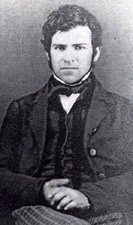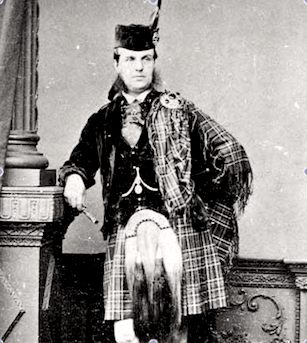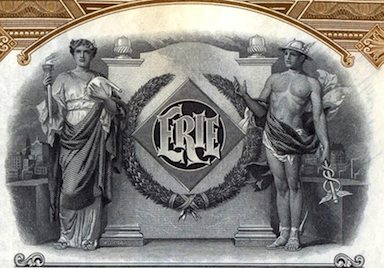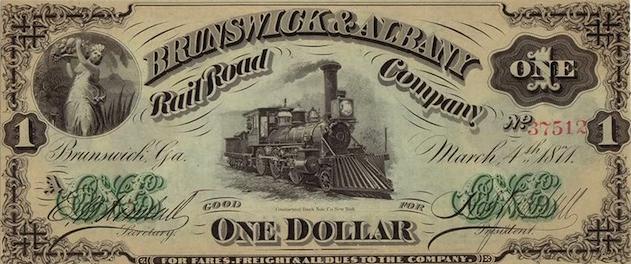The Big Con: Jay Gould, a British "Lord", and a $1 million bribe gone wrong
Dan Bryan, April 6 2012
It is often stated that the world of railroad financing was rife with abuse and outright fraud in the 19th century. It is less often, however, that specific stories are presented, even which such stories may shed light on the nature of such abuse.
The great con of the ruthless Jay Gould by a Scottish "Lord" is a spectacular example of just how badly things could turn against even the most jaded of investors.
Jay Gould: the indomitable tycoon
 Jay Gould in 1855. He was known as a man not to be trifled with.
Jay Gould in 1855. He was known as a man not to be trifled with.In 1870, Jay Gould was one of the richest and most successful railroad men in the United States. Known as a conniving speculator, he had profited from the crashes and panics that bankrupted many others. In 1869 he had tried to corner the U.S. gold market, and only failed when the U.S. Treasury opened its vaults to intervene. When Boss Tweed of Tammany Hall was arrested, Jay Gould was the man who posted most of the $1 million bond. He had once been caught in Albany carrying a suitcase overstuffed with $1,000 bills. In short, he was no stranger to the world of graft and corruption, and in fact had perpetrated more than his fair share.
Gould should have been the last man on earth to be taken by the charms of a striving con artist. Instead he fell for one of the biggest swindles of the entire 19th century.
Lord Gordon-Gordon: adventurer and "aristocrat"
Nobody knows the real name of "Lord Gordon-Gordon". In 1870 he arrived in the United States from Scotland without connections and set about making his fortune by rather unconventional means.
Gordon-Gordon came armed with a list of references from "aristocrats" in the highlands of Scotland. His initial story was that he was sent to purchase land in the plains on which Scottish immigrants could settle, and that these "aristocrats" as well as himself would be financing the operation. Over time he would modify this story to suit the purposes of his surroundings, but always with an artful motive.
 Lord Gordon-Gordon in Scottish attire
Lord Gordon-Gordon in Scottish attireGordon-Gordon's first stop in his American adventure was Minneapolis, Minnesota where be arrived in early 1871. By all accounts, Gordon-Gordon was a very well-dressed and well-spoken man, spent money rather freely (often on gifts for his new friends), and was a learned conversationalist. Having arrived in Minneapolis with $20,000 from some chicanery in the home country, he was immediately taken into society and invited to numerous dinner parties and social engagements.
Gordon-Gordon befriended some very prominent men, including railroad executives, who were excited about an influx of Scottish immigrants to the areas where they were laying track. Gordon-Gordon promised enough to keep their hopes up, but he had even bigger plans in mind. Armed with some glowing letters of reference he took his talents to New York, arriving there at the start of 1872.
A scheme for the control of the Erie Railroad
In New York the acceptance of Gordon-Gordon continued unabated. He became friends with Horace Greeley (editor of the New York Tribune), who was enthusiastic about the wealthy new arrival and his potential influence.
More importantly, Gordon-Gordon used his position and "wealth" to befriend Jay Gould, who at that time was engaged in a bitter power struggle for control of the Erie Railroad. Gordon-Gordon became so confident in his deceit that he convinced Gould to believe that he had sat in the House of Lords. He also somehow convinced Gould that he owned $30 million of Erie stock, and that he could bring much more to bear on the situation from his connections with nobles in England and Scotland.
 Detail from an Erie Railroad stock certificate
Detail from an Erie Railroad stock certificate$30 million was an obscene sum of money in 1872. How Gordon-Gordon got Jay Gould to swallow this whopper may never be known, but he must have been fantastically gifted in the black arts of the confidence man.
The vision of this money making itself known at the next stockholders' election must have beguiled Gould, for he made a very critical error of judgment. As a gesture of friendship to these "aristocrats" -- a bribe that is -- Gould provided Gordon-Gordon with around $1 million in Erie Railroad stock, cash, and other securities.
Gordon-Gordon sold off the stock in the markets almost as soon as he got his hands upon it. The infamous Gould had been taken in by a swindle of enormous proportions.
Gordon-Gordon becomes a fugitive
After some initial court proceedings Gordon-Gordon fled the country, traveling to Canada. Here the story grows even more outlandish. After searching in vain for the fugitive, Gould received a tip from a friend who recognized him in Winnipeg.
The Canadian courts did not take action against Gordon-Gordon, but Jay Gould's associates were not so hesitant. A team was organized to sneak into Manitoba and kidnap Gordon-Gordon. Their plan was to smuggle him back into the United States and try him in a criminal court.
Who would one expect to find in such a group? Military men perhaps, or young men seeking some adventure? Gould's associates were of a different class. Some key planners and participants in this operation were Michael Hoy, L.R. Bentley, Loren Fletcher, Eugene Wilson, and John Gilfillan:
- Michael Hoy became a U.S. Marshall for many years and was prominent in Minnesota law enforcement.
- L.R. Bentley was a Minneapolis businessman who had served a term in the State Congress of Minnesota.
- Loren Fletcher was also a Minnesota Congressman who would go on to a long career in the U.S. House of Representatives.
- Eugene Wilson was the mayor of Minneapolis and former U.S. Congressman who knew of the operation and coordinated legal efforts in its defense.
- John Gilfillan also served a term in the U.S. House.
In short, this bizarre mission was planned and carried out by some of the most prominent men in the state of Minnesota.
The failed kidnapping of Gordon-Gordon
On July 2, 1873 Gordon-Gordon was seized by Michael Hoy and another associate, bound by the hands and feet, and thrown into the back of a covered wagon. Before the kidnappers could could make it across the border, however, they were intercepted and arrested by Canadian police.
An outcry followed on both sides. The Canadians were upset that a team of bounty hunters had snuck across the border for the purposes of a kidnapping mission. The Americans were upset that the Canadians held these individuals without bail. Tensions flared to the point that the Minnesota militia was activated for a potential incursion into Manitoba. It was only after two months that the perpetrators were sentenced to twenty-four hours in prison and then released.
Unfortunately for Gordon-Gordon, the entire incident had placed him a bit too firmly in the spotlight. Word made its way to Canada of the fraud he had perpetrated in London. One gentleman had written a lengthy letter in which he concluded:
"I can consider him nothing else than an imposter, and yet who or what he is I know no more than the first day I saw him."
The end of Gordon-Gordon's illustrious career
Apparently even Gordon-Gordon was unable to talk himself out of the logic of such correspondence. A group led again by Gould was now able to obtain a warrant through the Canadian court system. Other persons in Canada and England also filed for arrest warrants. The notoriety made it impossible for Gordon-Gordon to continue his ruse.
This time there was no escape. Law enforcement apprehended Gordon-Gordon at the boarding house he was residing in. On some pretext he was able to return to his bedroom, where he shot himself through the head rather than submit to certain incarceration.
It was August 1, 1874. In three short years, Lord Gordon-Gordon cemented his reputation as one of America's great con artists.

